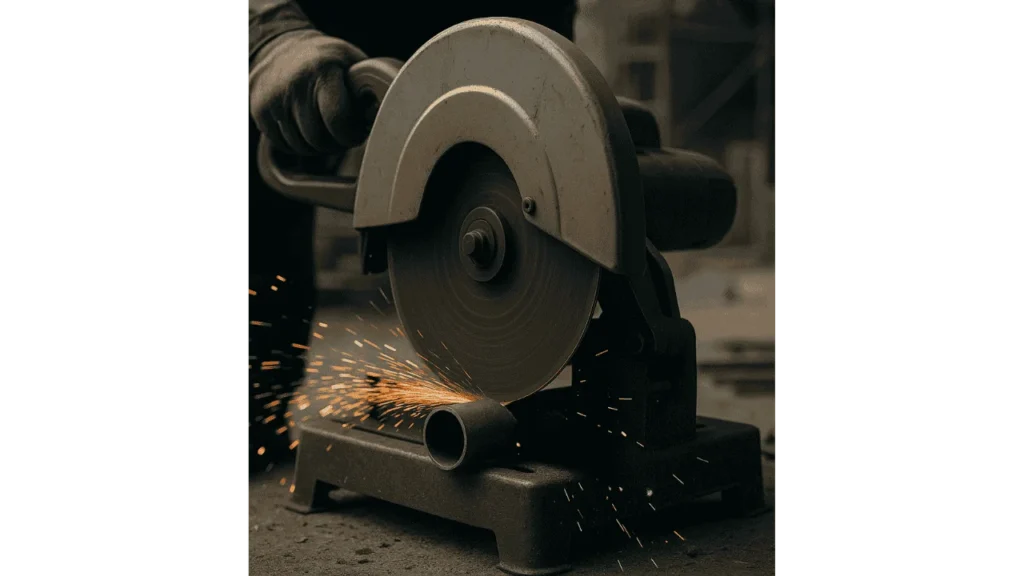A chop saw is a specialized tool designed to make straight, precise cuts in materials like metal, wood, and plastic. You’ll find it essential for construction, metalworking, and DIY projects, allowing you to work faster while maintaining accuracy. From my experience, using a chop saw consistently ensures cleaner cuts compared to manual methods, saving both time and effort. Understanding its purpose, types, and features helps you choose the right saw for your tasks while improving both efficiency and safety.

Types of Chop Saws
Abrasive Chop Saws
Abrasive chop saws use high-speed abrasive wheels to cut through tough materials. You can rely on them for jobs like cutting metal, rebar, and other sturdy components. In my experience, abrasive saws are ideal when speed and power matter more than finishing, such as during demolition or heavy fabrication. Always wear protective equipment because sparks and heat are generated during operation, and secure the material firmly to maintain control.
Cold Cut Saws
Cold cut saws feature toothed blades that produce cleaner and cooler cuts. You can cut metal with minimal heat and fewer sparks, which is important when maintaining material integrity. I’ve used cold cut saws for workshop projects where precision is critical, such as cutting aluminum framing or steel parts for fabrication. Ensuring the blade remains sharp and aligned allows you to achieve smooth, accurate cuts consistently.
Dry Cut Saws
Dry cut saws function similarly to cold cut saws but are optimized for specific metals such as steel and aluminium. You can cut without coolant, keeping the workspace clean and reducing setup time. In my experience, dry cut saws are excellent for repetitive metal cutting where maintaining consistent edge quality is essential. Proper clamping and blade selection are key to achieving precise results safely.
Key Features of Chop Saws
Chop saws usually have blade sizes ranging from 12 to 15 inches, allowing you to handle a variety of material thicknesses. Motor power typically ranges from 15 to 20 amps, providing sufficient force for efficient cutting.
“A saw with adequate motor power and the right blade diameter noticeably improves both speed and accuracy,” says tool technician Sarah Lopez.
Material clamping features, such as built-in clamps or vices, hold your workpiece securely, reducing movement and improving cut quality. Some models are portable, letting you transport them to job sites without compromising stability. From my hands-on experience, properly clamped materials make straight cuts much easier and safer.
Related: What is a Chop Saw Used For?
Common Applications
“Chop saws are versatile tools that allow you to achieve precise cuts across construction, metalworking, and DIY projects. Using the right type of saw and blade ensures both efficiency and safety,” says contractor Jack Harris.
Construction
You can use a chop saw to cut metal pipes, rebar, and structural components efficiently. On construction sites, having a chop saw on hand allows you to maintain consistent angles and lengths, which is vital for framing and assembly. From my experience, secure clamping and sharp blades make a significant difference in both speed and cut quality, helping you complete projects safely and accurately.
Metalworking
Chop saws are essential for fabricating metal parts and components. You can achieve uniform dimensions on repeated cuts, which is critical in any workshop environment. I’ve found that cold cut or dry cut saws prevent heat damage and preserve the edges, reducing the need for secondary finishing. Ensuring stability and using the right blade type allows you to work efficiently while producing professional-quality results.
DIY Projects
For home improvement tasks, a chop saw allows you to cut wood, aluminum, or plastic quickly and accurately. You’ll notice improved precision and reduced effort compared to manual sawing. In my experience, selecting the correct blade for the material and keeping the workpiece firmly secured ensures smooth, repeatable cuts, making DIY projects faster, safer, and more precise.
Safety Tips When Using a Chop Saw
You should always wear appropriate personal protective equipment, including safety goggles, gloves, and hearing protection. Ensure the workpiece is securely clamped before cutting to prevent shifting or kickback. Keep your hands and other body parts clear of the blade’s path at all times. Regularly inspect your saw for maintenance issues, such as blade condition or clamp integrity.
“Following safety procedures consistently reduces accidents and maintains the saw’s performance,” says David Miller, a professional tool expert.
Recommended Read: How to Use a Chop Saw?
FAQs
What is a chop saw used for?
A chop saw is primarily used for making straight, precise cuts in materials like metal, wood, and plastic.
How does a chop saw differ from a miter saw?
While both are used for cutting, a chop saw typically makes straight cuts, whereas a miter saw can make angled cuts.
Can a chop saw cut wood?
Yes, with the appropriate blade, a chop saw can cut wood, though it’s more commonly used for metal and other materials.
What safety precautions should be taken when using a chop saw?
Always wear safety goggles, gloves, and hearing protection. Ensure the material is securely clamped and keep hands clear of the cutting path.
How do I maintain my chop saw?
Regularly clean the saw, check for blade wear, and ensure all parts are functioning correctly. Refer to the manufacturer’s manual for specific maintenance guidelines.
Final Takeaways
Choosing the right chop saw is essential to achieve accurate and safe cuts for your projects. You should consider factors like material type, blade size, and motor power when selecting a saw. By understanding the types, features, and applications of chop saws, you can work more efficiently, maintain safety, and produce professional-quality results whether you are on a construction site, in a workshop, or completing DIY projects at home.
- How to Cut a Straight Line with a Jigsaw? - October 31, 2025
- How to Cut a Circle with a Jigsaw? - October 31, 2025
- Can You Cut Acrylic with a Jigsaw? - October 31, 2025
